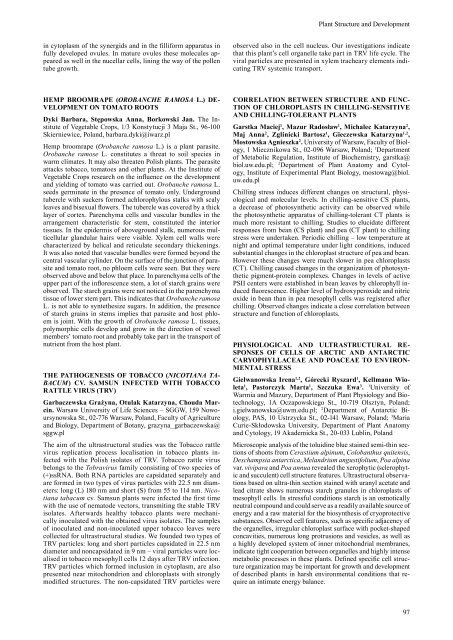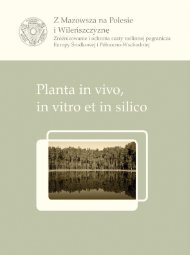acta societatis botanicorum poloniae - LV Zjazd Polskiego ...
acta societatis botanicorum poloniae - LV Zjazd Polskiego ...
acta societatis botanicorum poloniae - LV Zjazd Polskiego ...
Create successful ePaper yourself
Turn your PDF publications into a flip-book with our unique Google optimized e-Paper software.
in cytoplasm of the synergids and in the filliform apparatus in<br />
fully developed ovules. In mature ovules these molecules appeared<br />
as well in the nucellar cells, lining the way of the pollen<br />
tube growth.<br />
HEMP BrOOMrAPE (orobAnche rAmosA L.) dE-<br />
VELOPMENT ON TOMATO rOOTS<br />
dyki Barbara, Stępowska Anna, Borkowski Jan. The Institute<br />
of Vegetable Crops, 1/3 Konstytucji 3 Maja St., 96-100<br />
Skierniewice, Poland, barbara.dyki@iwarz.pl<br />
Hemp broomrape (Orobanche ramosa L.) is a plant parasite.<br />
Orobanche ramose L. constitutes a threat to soil species in<br />
warm climates. It may also threaten Polish plants. The parasite<br />
attacks tobacco, tomatoes and other plants. At the Institute of<br />
Vegetable Crops research on the influence on the development<br />
and yielding of tomato was carried out. Orobanche ramosa L.<br />
seeds germinate in the presence of tomato only. Underground<br />
tubercle with suckers formed achlorophylous stalks with scaly<br />
leaves and bisexual flowers. The tubercle was covered by a thick<br />
layer of cortex. Parenchyma cells and vascular bundles in the<br />
arrangement characteristic for stem, constituted the interior<br />
tissues. In the epidermis of aboveground stalk, numerous multicellular<br />
glandular hairs were visible. Xylem cell walls were<br />
characterized by helical and reticulate secondary thickenings.<br />
It was also noted that vascular bundles were formed beyond the<br />
central vascular cylinder. On the surface of the junction of parasite<br />
and tomato root, no phloem cells were seen. But they were<br />
observed above and below that place. In parenchyma cells of the<br />
upper part of the inflorescence stem, a lot of starch grains were<br />
observed. The starch grains were not noticed in the parenchyma<br />
tissue of lower stem part. This indicates that Orobanche ramosa<br />
L. is not able to syntethesize sugars. In addition, the presence<br />
of starch grains in stems implies that parasite and host phloem<br />
is joint. With the growth of Orobanche ramosa L. tissues,<br />
polymorphic cells develop and grow in the direction of vessel<br />
members’ tomato root and probably take part in the transport of<br />
nutrient from the host plant.<br />
THE PATHOGENESIS OF TOBACCO (nicotiAnA tAbAcum)<br />
CV. SAMSUN INFECTEd WITH TOBACCO<br />
rATTLE VIrUS (TrV)<br />
Garbaczewska Grażyna, Otulak Katarzyna, Chouda Marcin.<br />
Warsaw University of Life Sciences – SGGW, 159 Nowoursynowska<br />
St., 02-776 Warsaw, Poland, Faculty of Agriculture<br />
and Biology, Department of Botany, grazyna_garbaczewska@<br />
sggw.pl<br />
The aim of the ultrastructural studies was the Tobacco rattle<br />
virus replication process localisation in tobacco plants infected<br />
with the Polish isolates of TRV. Tobacco rattle virus<br />
belongs to the Tobravirus family consisting of two species of<br />
(+)ssRNA. Both RNA particles are capsidated separately and<br />
are formed in two types of virus particles with 22.5 nm diameters:<br />
long (L) 180 nm and short (S) from 55 to 114 nm. Nicotiana<br />
tabacum cv. Samsun plants were infected the first time<br />
with the use of nematode vectors, transmiting the stable TRV<br />
isolates. Afterwards healthy tobacco plants were mechanically<br />
inoculated with the obtained virus isolates. The samples<br />
of inoculated and non-inoculated upper tobacco leaves were<br />
collected for ultrastructural studies. We founded two types of<br />
TRV particles: long and short particles capsidated in 22.5 nm<br />
diameter and noncapsidated in 9 nm – viral particles were localised<br />
in tobacco mesophyll cells 12 days after TRV infection.<br />
TRV particles which formed inclusion in cytoplasm, are also<br />
presented near mitochondrion and chloroplasts with strongly<br />
modified structures. The non-capsidated TRV particles were<br />
Plant Structure and Development<br />
observed also in the cell nucleus. Our investigations indicate<br />
that this plant’s cell organelle take part in TRV life cycle. The<br />
viral particles are presented in xylem tracheary elements indicating<br />
TRV systemic transport.<br />
COrrELATION BETWEEN STrUCTUrE ANd FUNC-<br />
TION OF CHLOrOPLASTS IN CHILLING-SENSITIVE<br />
ANd CHILLING-TOLErANT PLANTS<br />
Garstka Maciej1 , Mazur Radosław1 , Michalec Katarzyna 2 ,<br />
Maj Anna2 , Zglinicki Bartosz1 , Gieczewska Katarzyna1,2 ,<br />
Mostowska Agnieszka 2 . University of Warsaw, Faculty of Biology,<br />
1 Miecznikowa St., 02-096 Warsaw, Poland; 1Department of Metabolic Regulation, Institute of Biochemistry, garstka@<br />
biol.uw.edu.pl; 2Department of Plant Anatomy and Cytology,<br />
Institute of Experimental Plant Biology, mostowag@biol.<br />
uw.edu.pl<br />
Chilling stress induces different changes on structural, physiological<br />
and molecular levels. In chilling-sensitive CS plants,<br />
a decrease of photosynthetic activity can be observed while<br />
the photosynthetic apparatus of chilling-tolerant CT plants is<br />
much more resistant to chilling. Studies to elucidate different<br />
responses from bean (CS plant) and pea (CT plant) to chilling<br />
stress were undertaken. Periodic chilling – low temperature at<br />
night and optimal temperature under light conditions, induced<br />
substantial changes in the chloroplast structure of pea and bean.<br />
However these changes were much slower in pea chloroplasts<br />
(CT). Chilling caused changes in the organization of photosynthetic<br />
pigment-protein complexes. Changes in levels of active<br />
PSII centers were established in bean leaves by chlorophyll induced<br />
fluorescence. Higher level of hydroxyperoxide and nitric<br />
oxide in bean than in pea mesophyll cells was registered after<br />
chilling. Observed changes indicate a close correlation between<br />
structure and function of chloroplasts.<br />
PHYSIOLOGICAL ANd ULTrASTrUCTUrAL rE-<br />
SPONSES OF CELLS OF ArCTIC ANd ANTArCTIC<br />
CArYOPHYLLACEAE ANd POACEAE TO ENVIrON-<br />
MENTAL STrESS<br />
Giełwanowska Irena 1,2 , Górecki ryszard 1 , Kellmann Wioleta<br />
1 , Pastorczyk Marta 1 , Szczuka Ewa 3 . 1 University of<br />
Warmia and Mazury, Department of Plant Physiology and Biotechnology,<br />
1A Oczapowskiego St., 10-719 Olsztyn, Poland;<br />
i.gielwanowska@uwm.edu.pl; 2 Department of Antarctic Biology,<br />
PAS, 10 Ustrzycka St., 02-141 Warsaw, Poland; 3 Maria<br />
Curie -Skłodowska University, Department of Plant Anatomy<br />
and Cytology, 19 Akademicka St., 20-033 Lublin, Poland<br />
Microscopic analysis of the toluidine blue stained semi-thin sections<br />
of shoots from Cerastium alpinum, Colobanthus quitensis,<br />
Deschampsia antarctica, Melandrium angustifolium, Poa alpina<br />
var. vivipara and Poa annua revealed the xerophytic (sclerophytic<br />
and succulent) cell structure features. Ultrastructural observations<br />
based on ultra-thin section stained with uranyl acetate and<br />
lead citrate shows numerous starch granules in chloroplasts of<br />
mesophyll cells. In stressful conditions starch is an osmotically<br />
neutral compound and could serve as a readily available source of<br />
energy and a raw material for the biosynthesis of cryoprotective<br />
substances. Observed cell features, such as specific adjacency of<br />
the organelles, irregular chloroplast surface with pocket-shaped<br />
concavities, numerous long protrusions and vesicles, as well as<br />
a highly developed system of inner mitochondrial membranes,<br />
indicate tight cooperation between organelles and highly intense<br />
metabolic processes in these plants. Defined specific cell structure<br />
organization may be important for growth and development<br />
of described plants in harsh environmental conditions that require<br />
an intimate energy balance.<br />
97



